BSA acquired Triumph Motorcycles in 1951 and in 1956 Edward Turner, Triumph’s chief design architect, had become Chief Executive of the BSA Automotive Group. Among the famous motorcycle designs attributed to Edward Turner, the smallest was the single cylinder, overhead valve 199 cc Triumph T20 Tiger Cub introduced in 1954, itself a slightly sportier version of the 149 cc Triumph T15 Terrier. These were Triumph’s first unit construction motorcycles with combined engine and gearbox.
With Edward Turner in charge, BSA introduced the 250 cc C15 in 1958 replacing the pre-unit C12. The C15 engine design was essentially copied from that of the Tiger Cub with the main change, apart from the increase in capacity, being the use of a vertically orientated cylinder rather than the forward leaning one on the Cub. Internally the engine layouts were very similar with one small difference being a change from the traditional Triumph plunger type of oil pump to the more usual BSA geared pump. Both engines used a distributor mounted behind the cylinder for the contact breaker points and both used a separate push rod tube on the right of the cylinder. They were fitted with a 4-speed, foot operated gearbox with more or less the same internal design.
The first bike I owned was a Tiger Cub that I then followed with a C15. I rode my Cub for many years but always considered its design a little fragile and really appreciated the more substantial engineering that went into the C15. This applied in particular to the engine. In my view, the Tiger Cub is a delightful bike and certainly follows Triumph’s flare for producing good looking motorbikes. While the C15 is also a good looking bike it is, perhaps, slightly more purposeful in its design and engineering than that of the Tiger Cub.
Although the C15 was first sold in 1958, it is customary to refer to its various models, as with other BSA models, in terms of its model year. The C15 was first sold in model year 1959 which began on 1 August 1958 and extended to 31 July 1959. The basic model of the C15 was named the C15 Star and continued in similar form up to and including model year 1967. It made use of the so-called Swan Neck frame that was derived from that of the Triumph Tiger Cub and consisted of a single down tube but, unlike that of the Tiger Cub, then split into two separate tubes under the engine. A sub-frame was bolted on to the rear to support the rear seat and mudguard, and to provide top mounts for the rear shock absorbers. The swinging arm was fitted with bushes and pivoted on a large diameter spindle that was an interference fit into the back of the frame. The lower end of the rear sub-frame was attached to either end of this spindle via special bolts with grease nipples fitted to allow lubrication of the swinging arm bushes.
The engine had front and rear lugs that enabled it to be bolted into the frame along with a long bolts through the bottom of the engine. It was fitted with a head steady which consisted of a triangular bracket bolted to the top of the head along with a clamp that fitted around the frame top tube. It made use of an AMAL 375 Monobloc carburettor.
The C15 Star was fitted with a headlight nacelle that extended downwards to cover the top of the fork stanchions. The headlight shell incorporated a lighting switch and an ammeter along with a speedometer. The bike was fitted with a smaller version of forks derived from those used on the larger Triumph motorcycles at the time and represented a scaled up version of the Tiger Cub forks. They were fitted with internal springs but no damping and had split ends to clamp the front wheel spindle. The C15 Star was fitted with 17″ wheels front and back, and 6″ full width, cast iron hubs.
The C15 Star came with a 2.5 gallon pear shaped petrol tank with pear shaped BSA badges and included knee pads. Unlike the Tiger Cub tank that bolted to the head stock on the Swan Neck frame in order to help to brace it, the C15 tank was fixed to the frame via a central bolt. The original tanks were painted all over but from 1962 they were painted to leave polished chrome panels on either side – these looked good but unfortunately greatly increased the cost of manufacturing them! The bike was fitted with painted valanced front and rear mudguards.
The bike had an oil tank on the right-hand side under the seat. On the opposite side was a metal side cover which housed a tool kit. Spanning the space between the oil tank and left-hand cover just in front of the rear down tube was a vertical panel. On the right-hand side of this panel was mounted the ignition switch; on the left-hand side was mounted a small projecting inlet tube for the shallow air filter that was fitted just behind the panel. A small rubber pipe was used to connect the carburettor to the air filter inlet. In the space between the oil tank and the tool box was fitted a battery carrier.
The C15 Star engine originally used a plain big-end bearing. However, in 1963 this was replaced by a roller big-end bearing that had been used earlier on the sportier C15 models and greatly strengthened the bottom end of the engine. The engine remained more or less the same until 1965 when its design was radically changed. The main change was to dispense with the distributor and to replace this with a contact breaker assembly in the side of the outer timing cover. This change necessitated a complete redesign of the inner timing cover and of the kickstart mechanism. During these changes, the original type of Tiger Cub kickstart spindle and pawl mechanism mounted inside the gearbox were replaced by a kickstart quadrant and ratchet mechanism on the outside of the inner timing cover.
A major change also took place in 1967 for the final C15G model. Up to this point, the engine used a bush for the timing side crankshaft bearing through which oil was pumped to the big-end bearing. The crankshaft had a caged ball bearing on the drive side. For the C15G model, the means of lubrication of the big-end bearing was changed and oil was then pumped in through a hole in the drive side end of the crankshaft (the so-called end fed crankshaft). This was a far more reliable means of lubrication and overcame the problem of wear in the original drive side bush affecting the oil pressure reaching the big-end bearing. The end fed crankshaft allowed the timing side bush to be changed to a caged ball bearing and the drive side to be changed to a roller bearing. These changes were a significant improvement in the design of the engine and were in line with the design of the 250 cc B25 engine that first appeared in this year.
Other C15 Models
A sportier version of the C15 was introduced in 1961 called the C15 Sports Star or SS80 with the 80 representing the maximum speed of the bike in a similar way to Triumph’s normal naming convention. The SS80 used a roller big-end instead of the plain bearing on the C15 Star, a sportier camshaft, a higher compression piston, a larger inlet valve and a larger bore AMAL 376 carburettor to give more output power. It was similar looking to the C15 Star except for the use of chrome plated mudguards. It continued in this form until the 1967 season although it was renamed the C15 Sportsman in 1965.
There were two C15 competition models produced in 1959 which continued up to and including the 1965 season: the C15 Trials and the C15 Scrambles. The engine for these models was similar to that of the standard C15 except for the use of a sportier camshafts and the use of a roller big-end bearing to give greater strength. It also incorporated an exhaust valve lifter. The C15T used a slightly lower compression ratio than standard (6.4:1 versus 7.5:1) and the C15S used a higher compression ratio (10:1). These models had low ratio gearboxes with that of the C15T being very low.
The original frame for the C15 S & T models was similar to the standard frame but this was changed in 1961 to remove the rear extensions normally used to mount the silencer and pillion footrests. This allowed the length of the rear shock absorbers and the ground clearance to be increased. However, the swan neck frame was very weak at the head stock and so in 1963 it was changed to a so-called welded duplex frame similar in concept to that used later for the B44 models. The C15 competition models used the so-called heavy weight forks with external springs. The C15T used a 20″ front and 18″ rear tyre and the C15S used a 20″ front and 19″ rear tyre. The competition models used a Lucas energy transfer ignition system and therefore dispensed with the battery. In its place, a much larger air filter was fitted that was different for the C15 T and S models. Originally, a pear shaped petrol tank was used for the competition models but this was changed to a smaller aluminium tank in 1963 similar to the later B44VS tank. A shorter saddle was fitted to the competition models together with a higher level silencer.
My C15 restoration
My C15 was built in 1967 and is therefore the final C15G model with end fed crankshaft. I bought the bike a long time ago at a low price but in very poor condition. Most of the tinware on the bike was rotten, including the petrol tank, and eventually most of this had to be replaced.
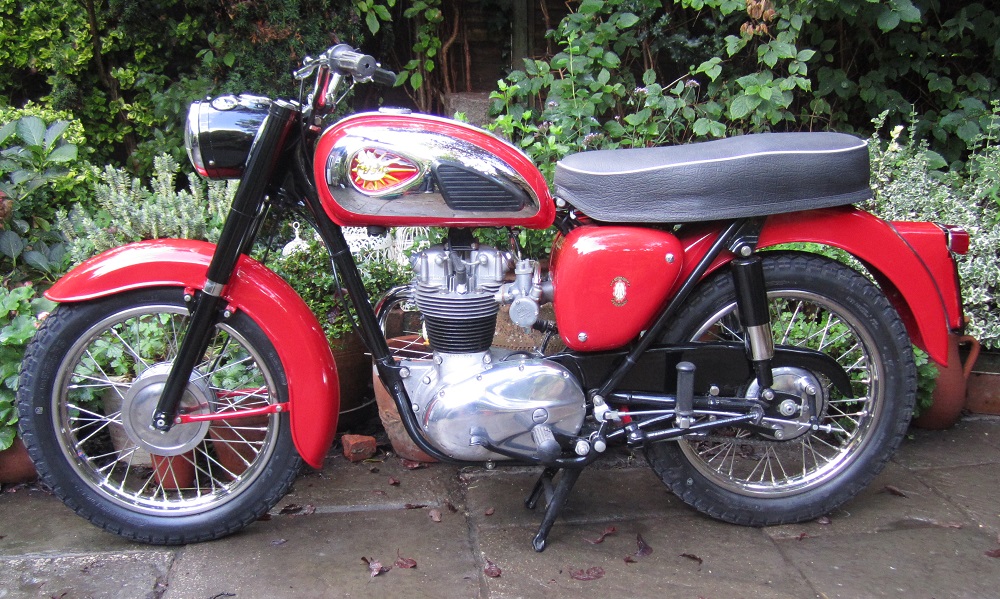
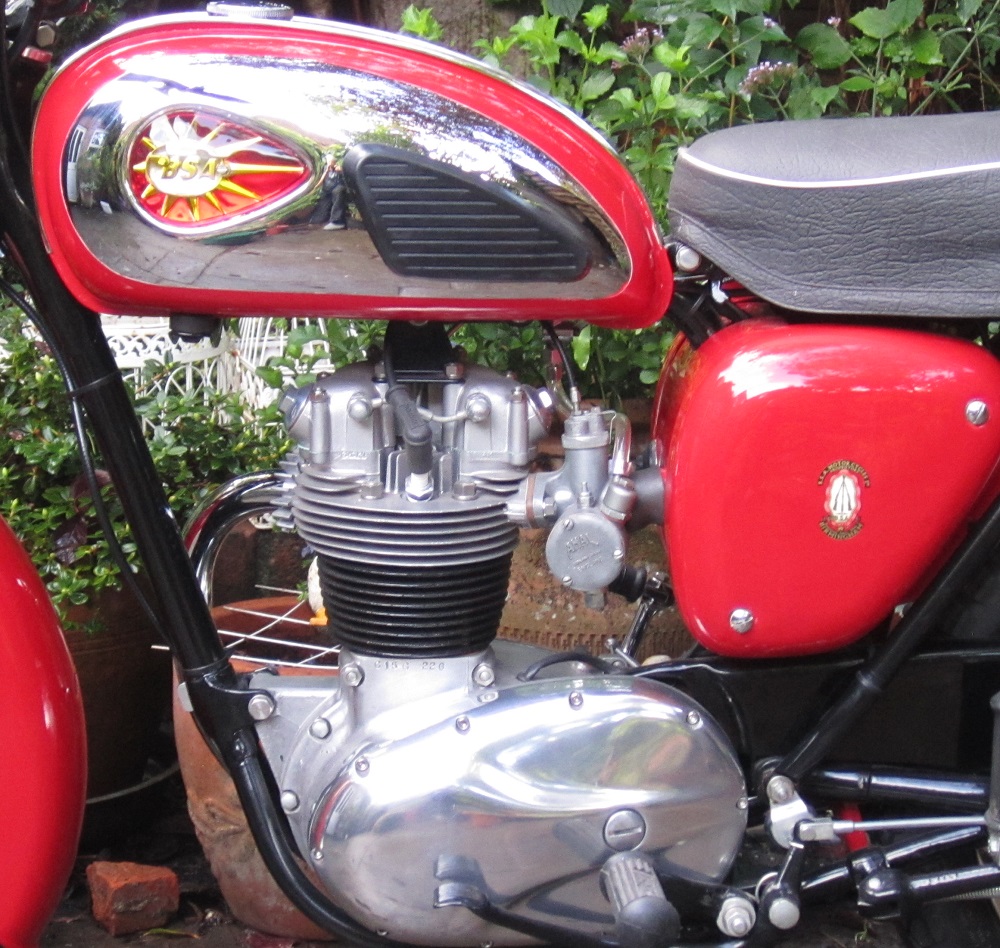
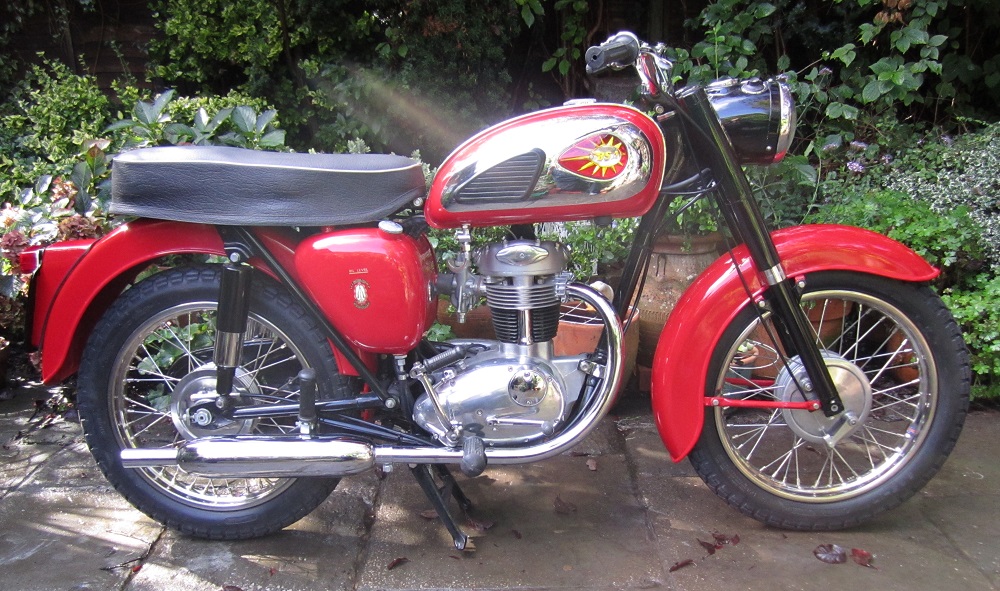
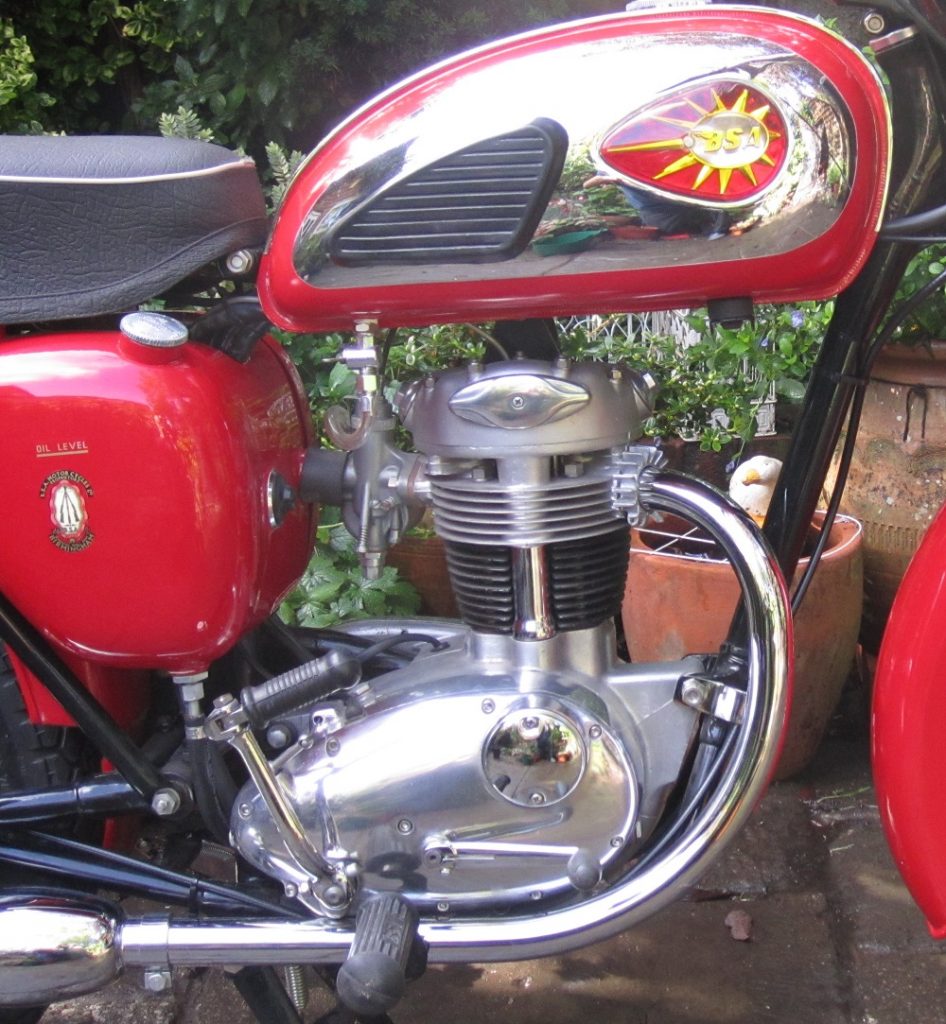
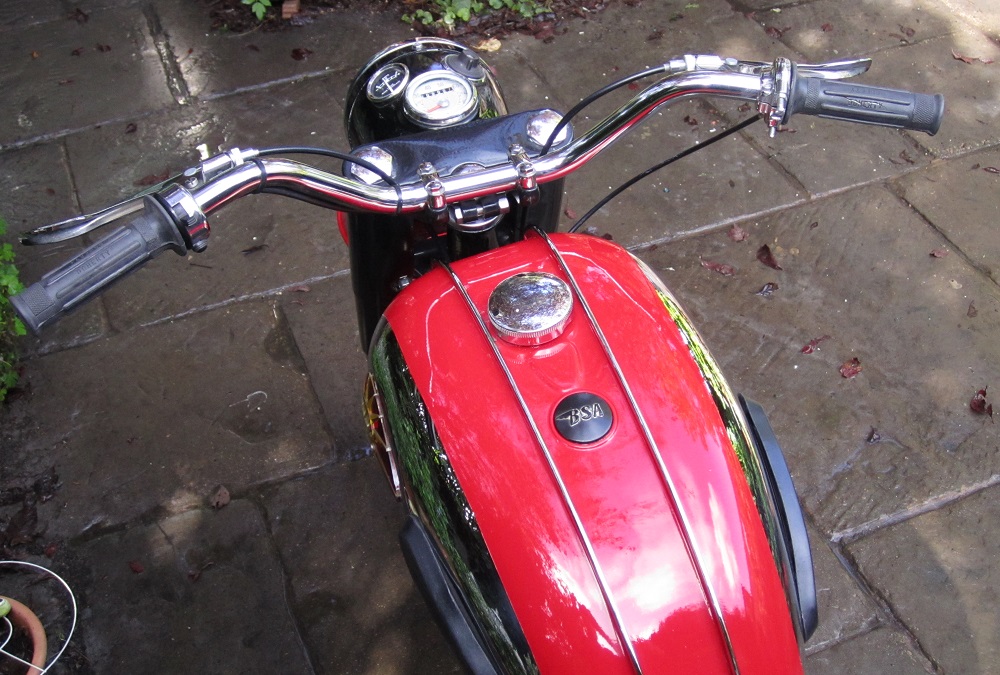 The engine was completely rebuilt with new bearings and seals. The cylinder was re-bored and both valves and springs were replaced along the primary chain and friction clutch plates. One of the main issues with the engine was that a number of the vertical cylinder head fins had broken off. Fortunately, the machine shop I use was able to build up the broken fins again using TIG welding followed by milling to the correct shape.
The engine was completely rebuilt with new bearings and seals. The cylinder was re-bored and both valves and springs were replaced along the primary chain and friction clutch plates. One of the main issues with the engine was that a number of the vertical cylinder head fins had broken off. Fortunately, the machine shop I use was able to build up the broken fins again using TIG welding followed by milling to the correct shape.
The main issue with the restoration of my C15G was that the original frame was bent presumably following an accident of some form. This resulted in the steering head being twisted to one side resulting in the front forks being out of alignment by quite a few degrees. Unfortunately, this is not unusual with this Swan Neck fame which was not very strong at the head stock. The frame could have been straightened but it was far more economical to simply replace the frame at a cost of £50 with another one in much better condition.
The frame was powder coated in gloss black. Much of the bike’s original tinware was too badly corroded to be restored and had to be replaced. This included the petrol tank and rear mudguard. The replacement tank was in reasonable condition and was chrome plated at great cost. The rest of the tinware, especially the mudguards, needed quite a bit of panel beating and other repairs before being painted. I spray painted all the tin ware in BSA Royal Red which was finished in a 2k clear coat. Compared with other BSA bikes I have restored (eg my A65L), there was a lot of tinware to paint on the C15 which included the petrol tank, mudguards, oil tank, tool box and front panel!
The original wiring harness for the bike was in poor condition and so this was completely re-made using the correct colour coded cables. Compared with other BSA bikes, the wiring harness for the C15 is relatively complicated due mainly to the use of 10-pole ignition and lighting switches with all the separate wires that that entailed. It was quite a challenge in particular to properly route this around the battery carrier to the ignition switch on the rear panel.
The cast iron wheel hubs were powder coated in silver and then the 17″ wheels were re-built with new stainless steel rims and spokes. I toyed with the idea of changing the wheel size to 18″ as per the B40 since this is often claimed to produce a better looking motorcycle. However, the centre stand provides very little lift for the back wheel on this particular bike and, with larger wheels, would then have proved to be ineffective. However, with 17″ wheels, I think the bike looks perfectly fine and I believe I made the right decision to keep this C15 to its factory specifications.
BSA C15 Specifications – Star Model
- Engine: Single cylinder, OHV 4-stroke
- Starting: Kickstart only
- Capacity: 247 cc
- Bore/Stroke: 67 x 70 mm
- Compression Ratio: 8.0:1
- Max Power: 15 hp
- Carburettor: Amal 375 Monobloc carburettor
- Cooling: Air cooled
- Lubrication: Dry sump
- Ignition: Coil and contact breaker points
- Transmission: 4 speed foot shift
- Final Drive: Chain
- Front Suspension: Coil spring and hydraulically damped
- Rear Suspension: Coil spring and hydraulically damped
- Front Brake: 6 inch drum single leading shoe
- Rear Brake: 6 inch drum single leading shoe
- Frame: Swan Neck
- Rake Angle: 65 deg
- Wheel Base 51 inch
- Seat Height: 32 inch
- Front Tyre 3.25 x 17 inch
- Rear Tyre: 3.25 x 17 inch
- Ground Clearance: 5 inch
- Dry Weight: 275 lb
- Fuel Tank: 3.0 gallons
- Oil Tank: 4 pints
BSA C15 Parts Suppliers
Most C15 spare parts are relatively easy to get hold of with many good suppliers easily found on the internet. Two of the larger suppliers of BSA parts are Burton Bike Bits and Dragonfly Motorcycles.
31,655 total views, 9 views today

